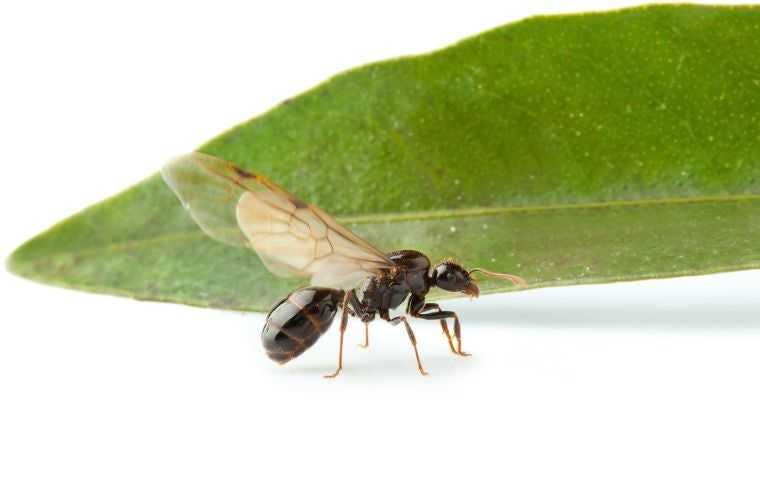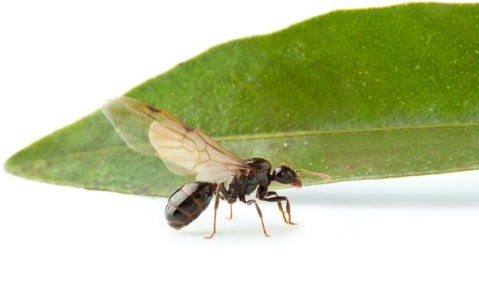Ants With Wings
September 13, 2023 - Ants

Ants with wings, often referred to as "winged ants" or "alates," are a crucial part of the ant life cycle and play a vital role in ant colonies' reproduction. These winged ants are typically found in mature ant colonies and are involved in the process of colony expansion and reproduction. Here is a comprehensive overview of ants with wings:
Life Stage and Purpose: Winged ants are not a separate species but rather represent a specific stage in the life cycle of ants. They are reproductive individuals, distinct from the worker ants. Their sole purpose is to leave the parent colony and establish new colonies.
Morphology: Winged ants have a distinct physical appearance that differentiates them from worker ants. They have two pairs of wings, with the front pair being larger than the hind pair. These wings are translucent and veined. They also have more robust bodies than worker ants, with well-developed reproductive organs.
Reproductive Behavior: When the time is right, typically during warm, humid weather, winged ants leave their parent colony in a swarm, an event known as "nuptial flight." During this flight, male and female winged ants from different colonies come together. Mating occurs in the air, after which the male ants die. The newly fertilized queens then land to start their own colonies.
Queen Ants: The fertilized female winged ants that successfully land and shed their wings become queen ants. They have a significantly longer lifespan compared to worker ants, potentially living for several years. Their primary role is to lay eggs and establish a new colony.
Worker Ants: Not all winged ants become queens. Some become workers in new colonies, where their primary duties include foraging, caring for the queen's offspring, and maintaining the colony. These ants also shed their wings after landing.
Colony Foundation: Once a queen ant has successfully mated and established a new colony, she lays eggs, which hatch into worker ants. This marks the beginning of a new ant colony. Over time, the colony grows as more worker ants are produced, and the cycle continues.
Species Variation: Winged ants can vary in size, color, and appearance depending on the ant species. Different ant species have specific times of the year when nuptial flights occur.
Economic and Ecological Significance: Ants, including winged ants, are ecologically important as they influence soil structure, nutrient cycling, and seed dispersal. Some ant species can also be agricultural pests, damaging crops. Understanding the biology and behavior of winged ants is crucial for pest management and ecological research.
Nuptial Flight Timing: The timing of nuptial flights for winged ants is closely tied to environmental factors like temperature, humidity, and photoperiod. Typically, these flights occur during warmer months, often in the spring or summer, when environmental conditions are conducive for successful mating and colony establishment. The exact timing can vary among ant species.
Winged Ant Diversity: Ants are incredibly diverse, with over 12,000 species known to science, and this diversity extends to winged ants. Different species exhibit unique adaptations, behaviors, and strategies for colony reproduction. Some species have striking coloration or patterns on their wings to deter predators during the nuptial flight.
Wing Retention: In some ant species, such as carpenter ants, the queen retains her wings even after landing to start a new colony. This is in contrast to most other ant species, where the queen sheds her wings shortly after landing. Retaining wings can provide additional protection for the queen as she establishes the colony.
Colony Founding Strategies: There are various strategies employed by queen ants when founding new colonies. Some queens are solitary and found colonies independently, while others may cooperate with other queens (polygyny) or even invade existing colonies to usurp control (infiltrative strategy). The choice of strategy depends on the ant species and ecological conditions.
Colony Size and Lifespan: The size of ant colonies can vary widely, from just a few individuals to supercolonies containing millions of ants. The lifespan of a colony also depends on factors such as the species, environmental conditions, and the presence of predators or disturbances.
Ecological Impact: Ants, including winged ants, play critical ecological roles. They are often considered ecosystem engineers because they modify their environment by building nests, aerating soil, and dispersing seeds. Some ant species form mutualistic relationships with plants by dispersing their seeds, aiding in plant growth and distribution.
Ant Predation: Many animals, such as birds, reptiles, amphibians, and even other insects, prey on winged ants during nuptial flights. These flights often provide a significant food source for predators, and the timing of the flights can be synchronized with predator behavior in some ecosystems.
Agricultural and Pest Management: While ants contribute positively to ecosystems, some species can become agricultural pests by damaging crops or invading homes. Understanding the behavior and life cycle of winged ants is crucial for effective pest management strategies.
Ant Social Structure: Ant colonies have complex social structures, with different castes of ants, including workers, queens, and males. The presence of winged ants during nuptial flights represents a key stage in the colony's life cycle, allowing for genetic diversity through mating between individuals from different colonies.
Winged ants are reproductive individuals that play a pivotal role in the perpetuation and expansion of ant colonies. Their unique morphology, reproductive behavior, and ecological significance make them a fascinating subject of study for entomologists and ecologists alike.
Customer Review
Bret came to our home to treat our pest issues same day and was thorough and knowledgeable! Pricing was lower than 4 other companies I'd contacted. Highly recommend!


